Abstract
5-Fluoro-2'-deoxycytidine (FdCyd) is a potent inhibitor of growth of tissue culture cells. The major cytotoxic event appears to be inhibition of thymidylate synthetase as evidenced by reversal of the cytotoxicity with thymidine but not deoxycytidine and by the effect of FdCyd on nucleotide pools, which is characteristic of specific inhibition of this enzyme. The metabolism of FdCyd was established by using a method in which its cytotoxicity was compared in several S-49 mutant cell lines having defined single or double deficiencies of enzymes involved in nucleoside and nucleotide metabolism. Our results indicate that FdCyd is metabolized to 5-fluoro-2'-deoxyuridylate, a potent inhibitor of thymidylate synthetase by two pathways: (i) sequential reactions catalyzed by deoxycytidine kinase and deoxycytidylate deaminase and (ii) sequential reactions catalyzed by cytidine deaminase and thymidine kinase. We have shown that metabolism of FdCyd can be directed through the former pathway by inhibition of cytidine deaminase with tetrahydrouridine. Since cytidine deaminase appears to be responsible for catabolism of FdCyd in animals, our results suggest that the antineoplastic effects of FdCyd should be examined in combination with inhibitors of cytidine deaminase.
Full text
PDF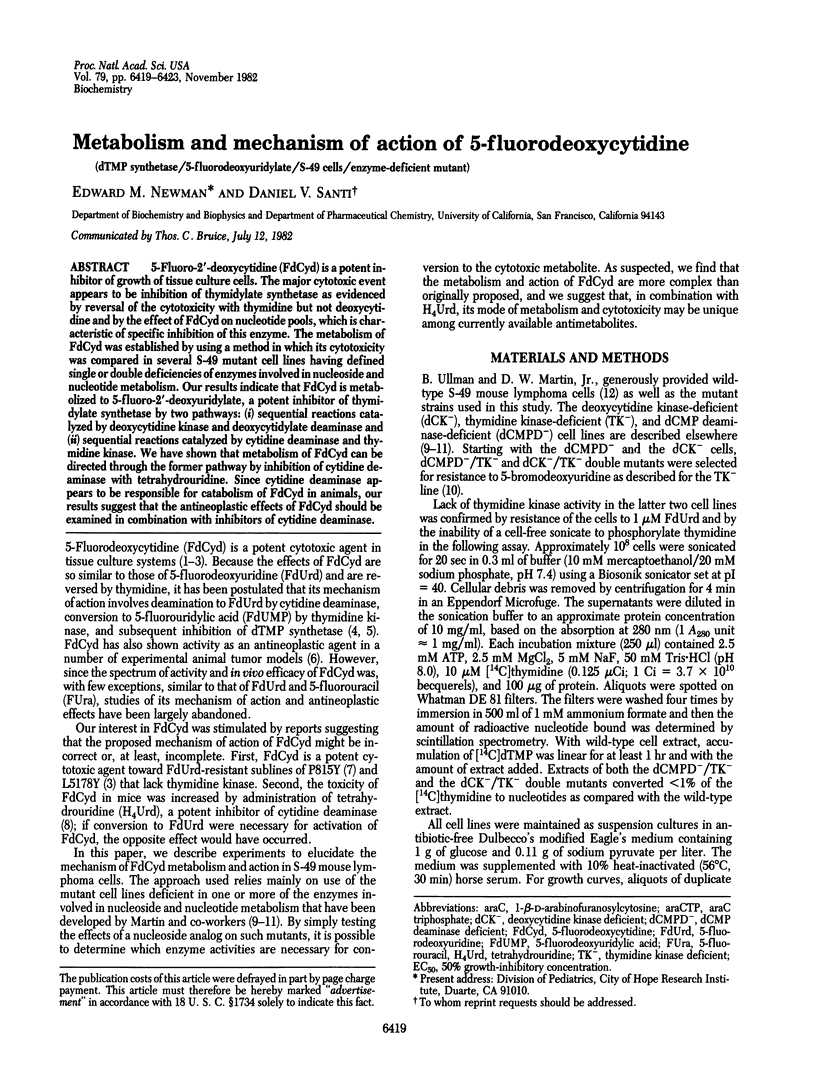
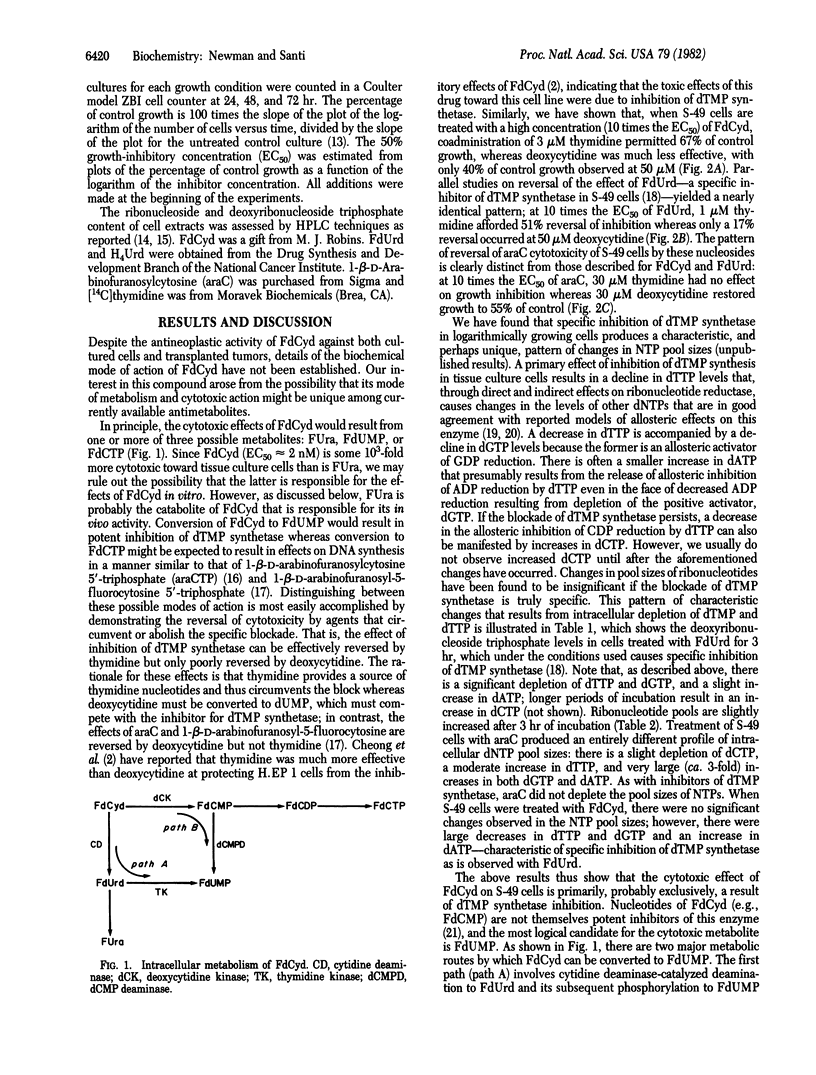
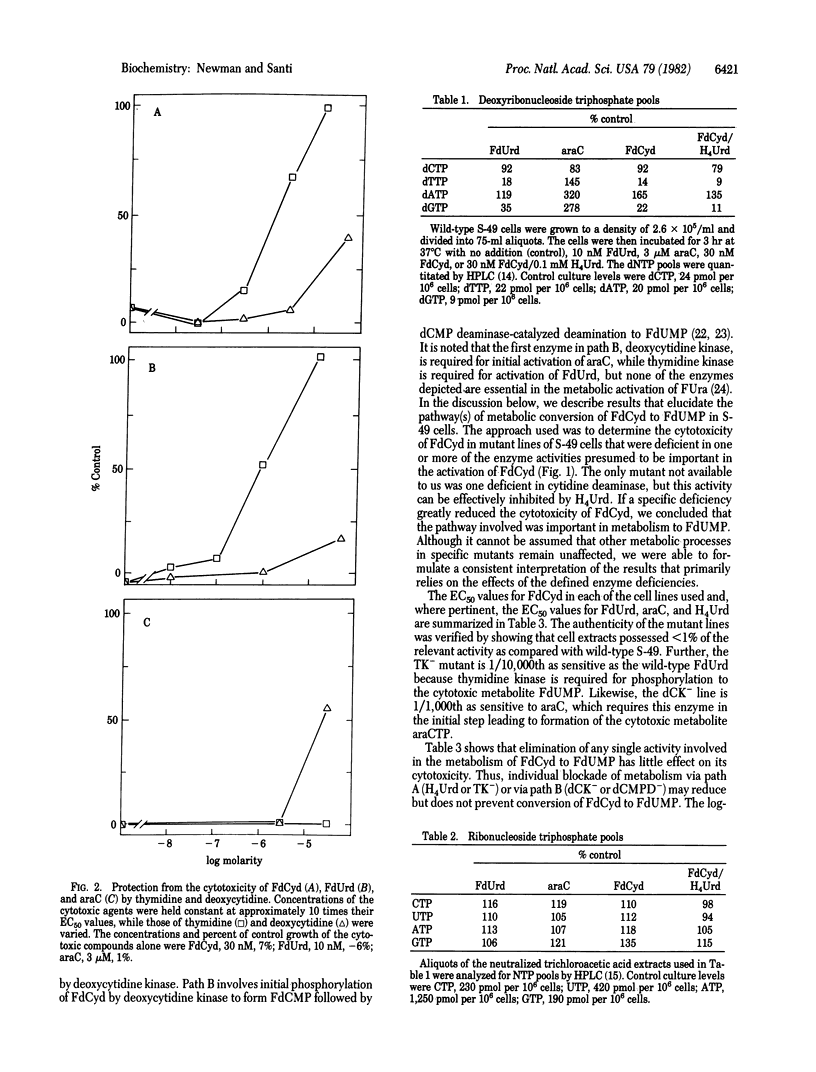
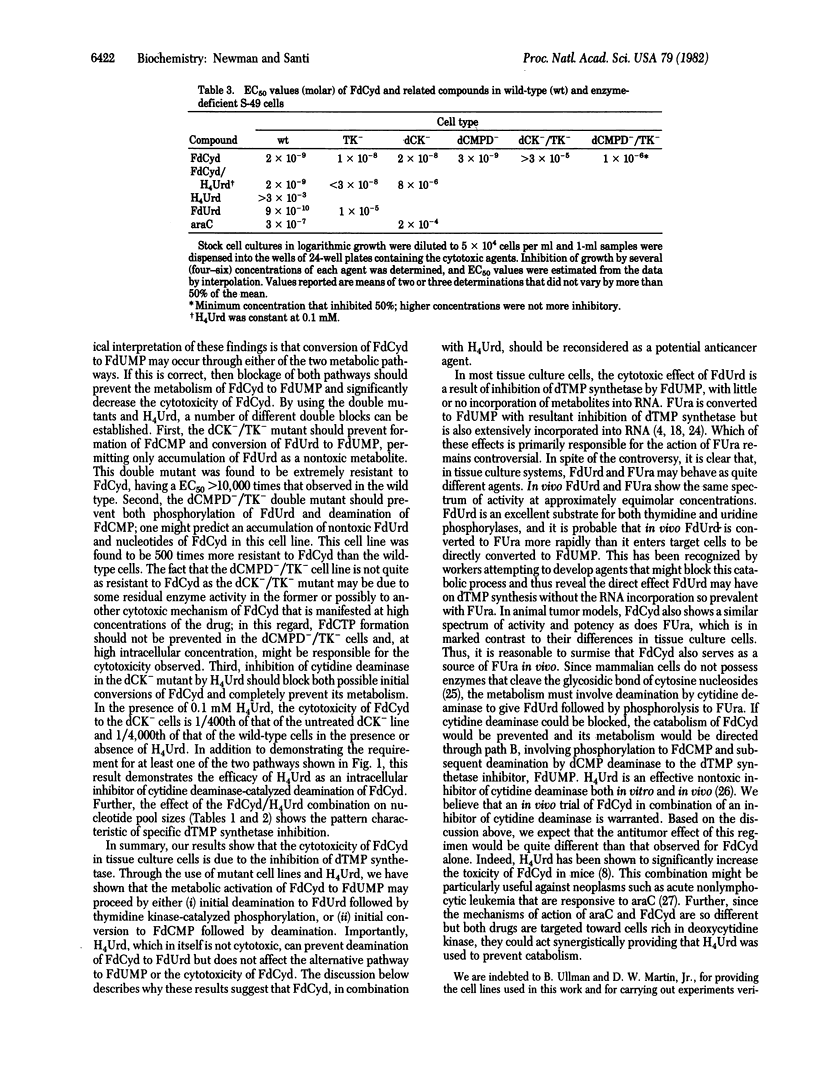
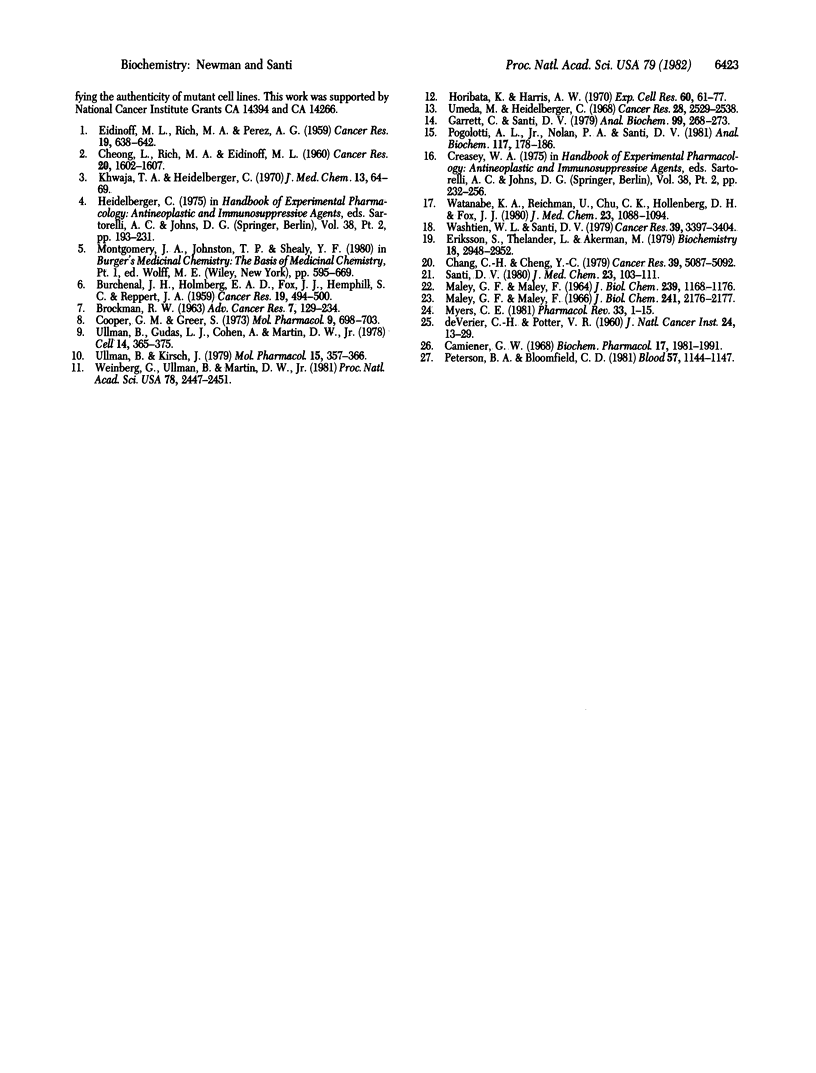
Selected References
These references are in PubMed. This may not be the complete list of references from this article.
- BROCKMAN R. W. MECHANISMS OF RESISTANCE TO ANTICANCER AGENTS. Adv Cancer Res. 1963;7:129–234. doi: 10.1016/s0065-230x(08)60983-5. [DOI] [PubMed] [Google Scholar]
- BURCHENAL J. H., HOLMBERG E. A., FOX J. J., HEMPHILL S. C., REPPERT J. A. The effects of 5-fluorodeoxycytidine, 5-fluorodeoxyuridine, and related compounds on transplanted mouse leukemias. Cancer Res. 1959 Jun;19(5):494–500. [PubMed] [Google Scholar]
- CHEONG L., RICH M. A., EIDINOFF M. L. Mechanism of growth inhibition of H.Ep. 1 cells by 5-fluorodeoxycytidine and 5-fluorodeoxyuridine. Cancer Res. 1960 Dec;20:1602–1607. [PubMed] [Google Scholar]
- Camiener G. W. Studies of the enzymatic deamination of ara-cytidine. V. inhibition in vitro and in vivo by tetrahydrouridine and other reduced pyrimidine nucleosides. Biochem Pharmacol. 1968 Sep;17(9):1981–1991. doi: 10.1016/0006-2952(68)90114-7. [DOI] [PubMed] [Google Scholar]
- Chang C. H., Cheng Y. C. Effects of nucleoside triphosphates on human ribonucleotide reductase from Molt-4F cells. Cancer Res. 1979 Dec;39(12):5087–5092. [PubMed] [Google Scholar]
- Cooper G. M., Greer S. The effect of inhibition of cytidine deaminase by tetrahydrouridine on the utilization of deoxycytidine and 5-bromodeoxycytidine for deoxyribonucleic acid synthesis. Mol Pharmacol. 1973 Nov;9(6):698–703. [PubMed] [Google Scholar]
- DE VERDIER C. H., POTTER V. R. Alternative pathways of thymine and uracil metabolism in the liver and hepatoma. J Natl Cancer Inst. 1960 Jan;24:13–29. doi: 10.1093/jnci/24.1.13. [DOI] [PubMed] [Google Scholar]
- EIDINOFF M. L., RICH M. A., PEREZ A. G. Growth inhibition of a human tumor cell strain by 5-fluorocytidine and 5-fluoro-2'-deoxycytidine: reversal studies. Cancer Res. 1959 Jul;19(6 Pt 1):638–642. [PubMed] [Google Scholar]
- Eriksson S., Thelander L., Akerman M. Allosteric regulation of calf thymus ribonucleoside diphosphate reductase. Biochemistry. 1979 Jul 10;18(14):2948–2952. doi: 10.1021/bi00581a005. [DOI] [PubMed] [Google Scholar]
- Garrett C., Santi D. V. A rapid and sensitive high pressure liquid chromatography assay for deoxyribonucleoside triphosphates in cell extracts. Anal Biochem. 1979 Nov 1;99(2):268–273. doi: 10.1016/s0003-2697(79)80005-6. [DOI] [PubMed] [Google Scholar]
- Horibata K., Harris A. W. Mouse myelomas and lymphomas in culture. Exp Cell Res. 1970 Apr;60(1):61–77. doi: 10.1016/0014-4827(70)90489-1. [DOI] [PubMed] [Google Scholar]
- Maley G. F., Maley F. The significance of the substrate specificity of T2r+-induced deoxycytidylate deaminase. J Biol Chem. 1966 May 10;241(9):2176–2177. [PubMed] [Google Scholar]
- Peterson B. A., Bloomfield C. D. Long-term disease-free survival in acute nonlymphocytic leukemia. Blood. 1981 Jun;57(6):1144–1147. [PubMed] [Google Scholar]
- Pogolotti A. L., Jr, Nolan P. A., Santi D. V. Methods for the complete analysis of 5-fluorouracil metabolites in cell extracts. Anal Biochem. 1981 Oct;117(1):178–186. doi: 10.1016/0003-2697(81)90708-9. [DOI] [PubMed] [Google Scholar]
- Santi D. V. Perspective on the design and biochemical pharmacology of inhibitors of thymidylate synthetase. J Med Chem. 1980 Feb;23(2):103–111. doi: 10.1021/jm00176a001. [DOI] [PubMed] [Google Scholar]
- Ullman B., Gudas L. J., Cohen A., Martin D. W., Jr Deoxyadenosine metabolism and cytotoxicity in cultured mouse T lymphoma cells: a model for immunodeficiency disease. Cell. 1978 Jun;14(2):365–375. doi: 10.1016/0092-8674(78)90122-8. [DOI] [PubMed] [Google Scholar]
- Ullman B., Kirsch J. Metabolism of 5-fluorouracil in cultured cells. Protection from 5-fluorouracil cytotoxicity by purines. Mol Pharmacol. 1979 Mar;15(2):357–366. [PubMed] [Google Scholar]
- Umeda M., Heidelberger C. Comparative studies of fluorinated pyrimidines with various cell lines. Cancer Res. 1968 Dec;28(12):2529–2538. [PubMed] [Google Scholar]
- Washtien W. L., Santi D. V. Assay of intracellular free and macromolecular-bound metabolites of 5-fluorodeoxyuridine and 5-fluorouracil. Cancer Res. 1979 Sep;39(9):3397–3404. [PubMed] [Google Scholar]
- Watanabe K. A., Reichman U., Chu C. K., Hollenberg D. H., Fox J. J. Nucleosides. 116. 1-(beta-D-Xylofuranosyl)-5-fluorocytosines with a leaving group on the 3' position. Potential double-barreled masked precursors of anticancer nucleosides. J Med Chem. 1980 Oct;23(10):1088–1094. doi: 10.1021/jm00184a006. [DOI] [PubMed] [Google Scholar]
- Weinberg G., Ullman B., Martin D. W., Jr Mutator phenotypes in mammalian cell mutants with distinct biochemical defects and abnormal deoxyribonucleoside triphosphate pools. Proc Natl Acad Sci U S A. 1981 Apr;78(4):2447–2451. doi: 10.1073/pnas.78.4.2447. [DOI] [PMC free article] [PubMed] [Google Scholar]


